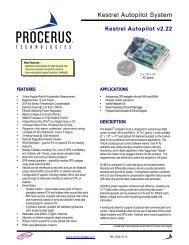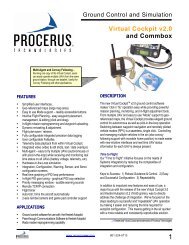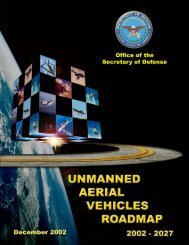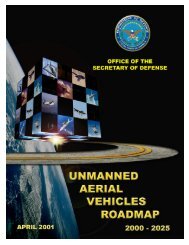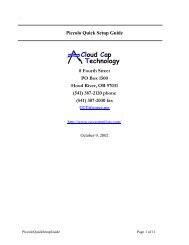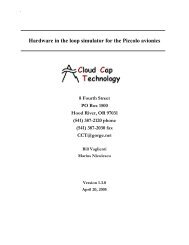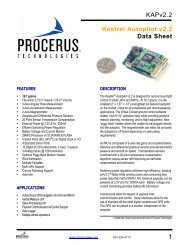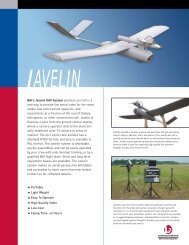JP 3-55.1 JTTP for Unmanned Aerial Vehicles - BITS
JP 3-55.1 JTTP for Unmanned Aerial Vehicles - BITS
JP 3-55.1 JTTP for Unmanned Aerial Vehicles - BITS
Create successful ePaper yourself
Turn your PDF publications into a flip-book with our unique Google optimized e-Paper software.
c. Communications. To the greatest extent possible, existingcommunications nets should be used between the UAV unit, supportedunits, and fire support or airspace control agencies. When thetactical situation permits, the UAV unit should maintain radiocommunications with the supported command centers and airspacecoordination element throughout flight operations. However, covert orsemicovert operations in emission controlled (EMCON) conditions maypreclude use of voice communications <strong>for</strong> operations security (OPSEC)reasons. Additional working nets can be maintained with supportedunits as appropriate. Units requesting support should coordinatefrequency management of UAV uplinks and downlinks and UAV unitfrequencies if the UAV is operating in areas other than its normaloperating areas. If downlinking in<strong>for</strong>mation via the remote videoterminal (RVT) to the supported unit, the UAV unit will provide theRVT while the supported unit will normally provide the RVT operator.4. Airspace Control. Airspace control is provided to prevent mutualinterference from all users of the airspace, facilitate air defenseidentification, and accommodate and expedite the flow of all air trafficsafely. The JFC, normally through his ACA, establishes joint <strong>for</strong>ceairspace control procedures in the ACP in accordance with the guidancecontained in Joint Pub 3-52, "Doctrine <strong>for</strong> Joint Airspace Control in theCombat Zone." UAV operations must be coordinated with the ACA toprovide safe separation of UAVs and manned aircraft and to preventengagement by friendly air defense systems. The established principlesof airspace management used in manned flight operations normally applyto UAV operations but may be waived by the JFC. UAV airspacerequirements do not differ from other low per<strong>for</strong>mance aircraft. The UAVis difficult to acquire visually and does not provide a clear radarsignature presenting a potential hazard to high per<strong>for</strong>mance aircraft.To limit the hazard to fixed-winged aircraft, separation between mannedaircraft and UAVs is required. UAV missions are both preplanned andimmediate in nature. Preplanned UAV flights in support of the JFC oranother service component should be included in the joint <strong>for</strong>ce ATO,SPINS, or ACO. Immediate UAV missions will be coordinated withappropriate airspace control agencies (i.e. ASOC, DASC, AOC, TACC) toprovide safe separation between manned and unmanned aircraft and preventinadvertent engagement by friendly air defense artillery (ADA) orfighters. UAVs are launched from UAV launch and recovery sites (LRSs),which may be either airfields, unimproved field locations, or largeflight decks afloat depending on the type or size of UAV. After launch,the UAV can climb to flight route or transit altitude (normally aboveII-6



